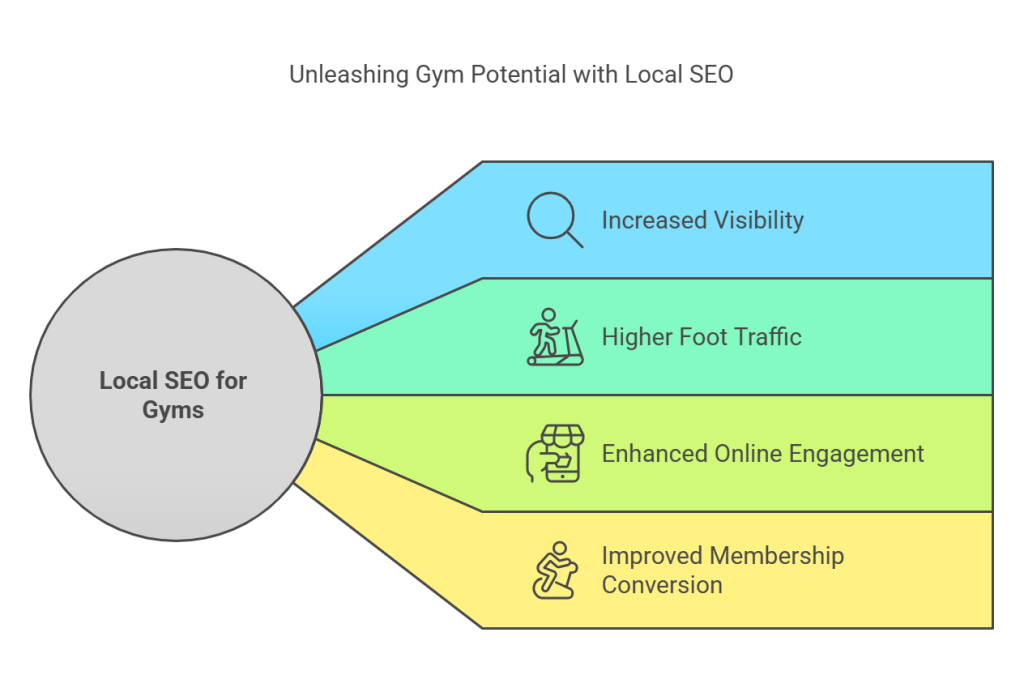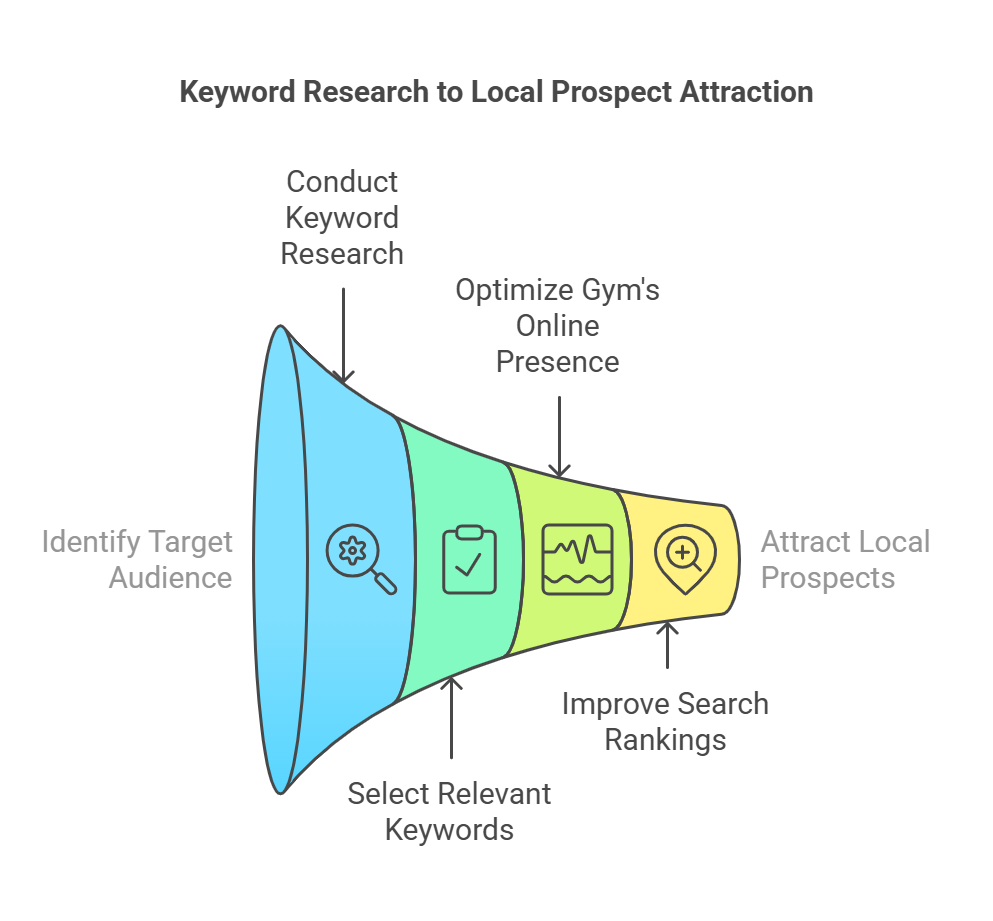
Introduction
In today’s digital age, Local SEO has become a vital tool for businesses to stand out, especially for gyms. With more people turning to Google for their fitness needs, ranking well in local searches is critical for attracting new clients. By strategically using local keywords, gyms can increase their visibility and connect with potential members. As the fitness industry continues to grow, online visibility has become an essential factor for success. People searching for gyms or fitness solutions are more likely to choose those that appear at the top of search engine results, particularly when those results are tailored to their location. Local SEO is the bridge that connects gyms to the clients who need them the most.
The Growing Importance of Being Found Online
People looking for gyms near them use location-based searches such as “best gym near me” or “gym in [City]”. These searches have become the primary method for potential clients to find businesses that meet their specific needs. Optimizing for these location-based queries not only helps you appear in local search results but ensures your gym is visible when clients are actively searching for fitness options in their area. In fact, according to Google, almost 46% of all searches have local intent. This highlights the importance of ranking high in these results, as clients are more likely to visit businesses that appear in local search results. Whether they’re looking for a gym that offers specific services or just seeking a nearby location, local SEO ensures you’re the one they find.
How Local SEO Can Attract More Clients to Your Gym
Local SEO helps gyms target people who are within their geographic proximity, making it easier for them to find your business when they need it most. The proximity factor is key, as it places your gym in front of clients who are already in your area, looking for a convenient option. This increases your chances of driving foot traffic to your gym, as well as online engagement from individuals considering a membership. The more visible you are in local searches, the more likely it is that people will click on your website or drop by in person. A properly optimized local SEO strategy ensures that your gym can be found by local prospects, making it easier for them to make the decision to visit or sign up.
The Role of Keyword Research in Building a Strong Online Presence
Keyword research is foundational for local SEO. It helps gym owners identify the search terms and phrases that potential clients are using to find fitness services in their area. By understanding the language and needs of your target audience, keyword research enables you to create content that resonates with them, driving more organic traffic to your website. Local keyword research helps gyms rank for highly relevant terms like “gym in [City]”, “personal training near me”, or “affordable fitness center”. With the right keywords, your gym can appear in front of those searching for exactly what you offer, whether it’s a specific type of fitness class or a convenient location. Engaging content built around these keywords also enhances your visibility and engagement, making your gym the go-to choice for potential clients in your area.
Demystifying Local SEO for Gym Owners
What is Local SEO and Why Does It Matter for Gyms?
Local SEO optimizes your online presence to rank well for location-based searches. For gyms, this means ensuring your business appears when potential clients search for fitness centers, personal trainers, or related services in their local area. Without a well-executed local SEO strategy, your gym may remain invisible to the very people who need your services most — those searching for a gym nearby. In today’s competitive fitness market, having a strong local online presence is crucial for attracting new members and building brand visibility within your community.
Local SEO Explained in Simple Terms
Simply put, Local SEO is a strategy that focuses on improving your online presence so that your gym ranks higher in local search results. This involves optimizing various aspects of your online presence, including your website, Google My Business profile, and other online listings. By focusing on local SEO, you ensure that your gym is visible when someone in your area searches for services like “gym near me” or “personal trainers in [City].” Effective local SEO increases your chances of showing up in these search results, which directly leads to more foot traffic and sign-ups.
Why Gyms Thrive on Location-Based Searches
Gyms naturally rely on their physical location to attract clients. Local searches are critical for driving foot traffic and membership sign-ups. Whether you’re a yoga studio, a high-end fitness center, or a 24-hour gym, location-based searches are how most people find you. Potential clients often look for gyms that are close to their home or work, and optimizing for these searches ensures that you show up when people are looking for services in your geographic area. When your gym appears in the search results for local queries, you have the opportunity to attract clients who are actively looking for a place to work out nearby.
The Unique Benefits of Local SEO for Gyms
- Driving Foot Traffic and Membership Sign-ups:
Local SEO makes it easier for your gym to be discovered by potential clients who are nearby. When people search for terms like “gym near me” or “fitness center in [City],” an optimized local SEO strategy ensures that your gym is one of the first businesses they see. This increased visibility drives foot traffic and encourages more people to walk through your doors or sign up for a membership online. - Standing Out in a Crowded Fitness Market:
Many gyms are competing in the same city or neighborhood, making it essential to differentiate yourself. Local SEO helps your gym stand out by improving your ranking in local search results. By appearing higher in searches relevant to your area, your gym has a better chance of being noticed by potential clients who may otherwise overlook your competition. - Becoming the Go-To Gym in Your Community:
Ranking high in local search results increases your gym’s credibility and establishes it as a trusted brand within your community. People tend to choose businesses that appear at the top of search results, associating high rankings with authority and trustworthiness. With strong local SEO, you position your gym as the top choice for fitness services in your area, fostering greater trust and long-term loyalty from members.
Keyword Research 101: Building Blocks of Local SEO
What is Keyword Research and Why is It a Game-Changer?
Keyword research is the process of identifying the specific words and phrases that your target audience is searching for online. For gyms, this means understanding what potential members are typing into search engines when they are looking for fitness services in your area. Conducting effective keyword research allows you to connect with these potential clients by ensuring your gym shows up in relevant search results.
By targeting the right keywords, your gym can appear when someone is looking for services you offer, such as “gym near me” or “personal trainer in [City].” This direct connection with potential clients makes keyword research a game-changer, as it helps drive more qualified traffic to your website and, ultimately, more foot traffic to your gym.
How Keyword Research Connects Your Gym to Potential Clients
When you conduct thorough keyword research, you identify the terms that potential clients use when searching for gym-related services in their local area. For example, phrases like “gym in [City]” or “personal trainer near me” are location-based search queries that connect users to gyms in their proximity. By optimizing your website and online presence with these keywords, you ensure your gym appears in search results when people are actively looking for fitness services nearby.
Incorporating these local search terms into your website, Google My Business profile, and other online listings can help you capture high-quality leads — people who are already looking for a gym in your area. This process enhances your visibility and increases the chances of converting searchers into new gym members.
Common Mistakes Gym Owners Make Without Proper Keyword Targeting
- Ignoring Long-Tail Keywords:
Many gym owners make the mistake of focusing solely on short-tail keywords like “gym” or “fitness,” which are highly competitive. These broad keywords are often hard to rank for, and they may not always lead to conversions. Long-tail keywords, on the other hand, are more specific and have less competition. For example, keywords like “best gym for weightlifting in [City]” or “affordable gym in [City]” can attract highly targeted traffic with higher conversion potential. - Forgetting Local Intent:
Failing to include local intent in your keyword strategy can result in missed opportunities. While general terms like “gym” are important, without location-based keywords, you might miss out on people specifically looking for gyms in their area. For example, someone searching for “gym near me” or “fitness center in [City]” is looking for a local gym, and by ignoring these types of terms, your gym could get overlooked by local prospects who are actively seeking your services.
Different Types of Keywords Every Gym Should Know
- Short-Tail Keywords:
These are general, broad search terms like “gym,” “fitness,” or “personal trainer.” While these keywords can drive traffic, they are highly competitive and may not be the best way to attract highly targeted leads. - Long-Tail Keywords:
These are more specific, low-competition phrases that can attract more qualified prospects. For example, “best gym for women in [City]” or “affordable gym in [City]” are long-tail keywords that focus on a specific type of gym or service. These keywords tend to have lower search volume but are more likely to convert visitors into gym members due to their specificity. - Geo-Targeted Keywords:
These keywords include location-specific terms that connect your gym to a particular area. Examples include “gym in [City],” “fitness center near [neighborhood],” or “24-hour gym in [City].” Geo-targeted keywords are essential for local businesses, as they ensure that your gym is visible to people searching for services within your geographic area. - Keywords for Different User Intents:
- Informational Intent: These users are seeking information. For example, “how to build muscle at the gym” or “best exercises for weight loss.” While these users may not be ready to sign up for a gym membership yet, creating helpful content around these keywords can attract people interested in fitness topics.
- Navigational Intent: These users are looking for a specific gym. For example, “Gold’s Gym in [City]” or “Planet Fitness in [City].” If you have a well-established gym brand, targeting navigational intent keywords can help users find your exact location.
- Transactional Intent: These users are ready to take action, like signing up for a gym membership. Examples include “buy gym membership in [City]” or “sign up for gym near me.” These are high-intent searches and are crucial for gym owners aiming to convert online searches into actual memberships.
By understanding and targeting these various types of keywords, you can tailor your content and SEO efforts to better align with what potential clients are searching for. This strategic approach to keyword research helps you attract more qualified traffic, engage with local clients, and ultimately grow your gym business.
Why Local Keyword Research is Critical for Gym Success 
Speaking Your Client’s Language: The Power of Relevance
Effective keyword research ensures that your gym speaks directly to the needs and desires of your target audience. The relevance of your keywords is essential — if your keywords align with what users are actively searching for, your gym will rank higher in local search results. By targeting the right keywords, such as “affordable gym near me” or “24-hour fitness in [City],” you connect with people looking for exactly what your gym offers, increasing the chances of attracting local prospects.
Capturing Searches Like “Affordable Gym Near Me” or “24-Hour Fitness in [City]”
Including keywords that people frequently search for, such as “affordable gym” or “24-hour fitness,” makes it more likely that your gym will appear in search results when people are looking for a gym nearby. These are highly relevant phrases that match local users’ needs, making it easier for them to find you when they need fitness solutions.
Making it Easy for Locals to Find You When They Need Fitness Solutions
By optimizing your website and online presence for local searches, you make it easier for people in your vicinity to find your gym, visit your website, or even drop by for a tour. Local SEO ensures your gym is visible at the exact moment someone in your area is looking for fitness services, creating a seamless path from search to in-person visits.
How Local Keywords Boost Engagement and Membership
When your gym ranks for the right local keywords, it doesn’t just increase the number of clicks on your website — it increases the likelihood of turning those clicks into real members. Keywords like “best gym for beginners” or “gym with personal trainers” target specific user intents that lead to conversions. By focusing on the needs of potential clients, you can boost engagement and drive memberships.
Why Being #1 in Local Search Results Matters
Research shows that nearly 33% of all clicks go to the top-ranking result on Google. Being the #1 result for local searches significantly improves your gym’s visibility, leading to more walk-ins and increased membership sign-ups. The higher you rank in local search results, the more likely people are to find and choose your gym over others in the area.
Turning Searches into Sign-Ups: Keywords That Convert
To maximize the effectiveness of local keyword research, craft strong calls-to-action (CTAs) that incorporate targeted local keywords. For instance, “Join our gym today in [City]” or “Get started with a free trial in [City]” can directly influence potential members to take action and sign up. By linking local keywords with compelling CTAs, you increase your chances of converting online searches into actual gym memberships.
Proven Strategies to Implement Local SEO for Your Gym
Mastering Local Keyword Research
Utilize tools like Google Keyword Planner, Ahrefs, and SEMrush to identify valuable keywords for your gym business. These tools can help you discover high-traffic terms related to your fitness niche and geographic location, allowing you to optimize your website for the right local searches.
Optimizing Your Website for Local Searches
To improve your local SEO, incorporate location-based keywords in crucial on-page SEO elements, such as:
- Titles
- Meta descriptions
- Heading Tags
- Image Alt tags
Additionally, create landing pages tailored to specific areas your gym serves, ensuring that users searching for gyms in different neighborhoods can easily find relevant information.
Building a Strong Local Presence
- Google My Business (GMB): Perfect your GMB profile by including accurate information about your gym’s location, hours, services, and contact details. This helps local searchers find and connect with your gym more easily.
- Local Directories: List your gym in high-authority local directories such as Yelp, Yellow Pages, or fitness-specific sites. Being listed on reputable platforms increases your online visibility and credibility.
- Encourage Reviews: Ask happy members to leave reviews on Google or other review platforms. Positive reviews can enhance your gym’s reputation and improve local rankings.
Taking Local SEO to the Next Level
Creating High-Value Content That Targets Local Keywords
Create blog posts, success stories, and testimonials that resonate with your local community’s needs and incorporate local keywords. Articles like “Best Gyms for Weightlifting in [City]” or “Why Our Gym is the Top Choice for Personal Training in [City]” provide value to local clients and increase the chances of attracting their attention through search engines.
Tracking and Tweaking Your SEO Efforts
Use tools like Google Analytics and Google Search Console to monitor how your local keywords are performing. These tools allow you to analyze user behavior, traffic patterns, and keyword rankings, enabling you to adjust your SEO strategy accordingly for better results.
Using Social Media for Local Engagement
Social media platforms such as Facebook, Instagram, and Twitter offer opportunities to engage with your local community. You can create geo-targeted ads to reach potential clients within your area and partner with local influencers to boost your gym’s visibility. Social media can further amplify your local SEO efforts and generate additional traffic to your website.
Conclusion
By leveraging local keyword research, you can increase your gym’s visibility, attract new clients, and build a strong, engaged community. Take actionable steps today to implement local SEO strategies and position your gym as the go-to fitness destination in your area. Local SEO is the key to standing out in the competitive fitness market and ensuring that your gym is the first choice for local fitness enthusiasts.
Frequently Ask Question (FAQ)
What is Local SEO and why is it important for my gym?
Local SEO optimizes your gym’s online presence for location-based searches. It’s important because it helps your gym appear in search results when potential clients search for fitness services near them, increasing your visibility and foot traffic.
How do I find the best keywords for my gym’s website?
You can use tools like Google Keyword Planner, Ahrefs, or SEMrush to find local and relevant keywords. Focus on terms that potential clients are searching for in your area, such as “gym near me,” “personal trainer in [City],” or “affordable fitness center.”
Can local SEO help increase my gym’s membership sign-ups?
Yes, local SEO can attract more people to your website and gym. By optimizing your site for local searches and using targeted keywords, your gym becomes more visible to individuals actively looking for fitness services in your area, leading to more sign-ups.
How long does it take to see results from local SEO for my gym?
SEO results vary depending on several factors, including competition and the strength of your website. Generally, it can take 3 to 6 months to start seeing noticeable results, but consistent effort in optimizing your site can yield long-term benefits.
How do I encourage positive reviews for my gym?
You can encourage reviews by simply asking satisfied clients to leave feedback on your Google My Business page or other review platforms. Offering excellent service, creating a positive experience, and reminding clients to share their thoughts can help generate positive reviews.


